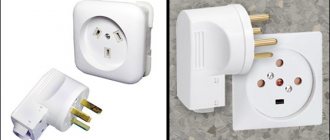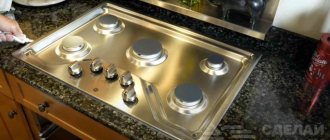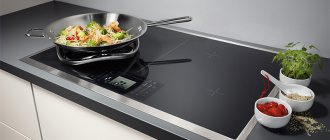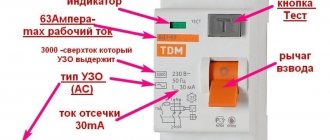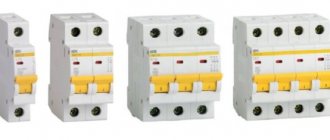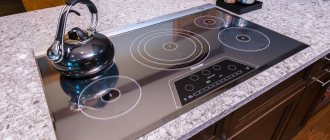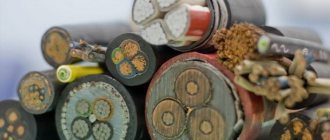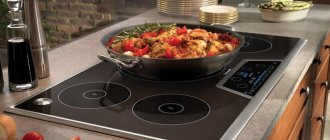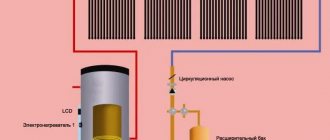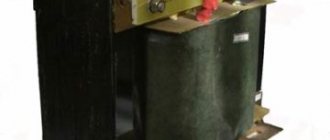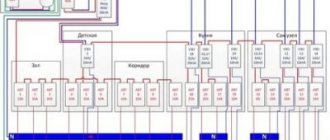Connecting a hob, oven or electric stove is exactly the case when you MUST read the instructions.
At least to find out how much the connected electrical appliance consumes, what kind of wire, automatic and automatic device is needed for connection.
But this is not enough to be completely sure that everything has been done correctly and will not have to be redone.
Regardless of whether you connect it yourself or invite a specialist, you need to be confident in the future - in the sense that a miscalculation in the current of the RCD (hereinafter referred to as difavtomat ) or the cross-section of the wire can lead to a fire. An average oven is designed to consume 2-3 kW of electricity , hob - up to 7 kW. Grounding of devices is mandatory. The hob (and, if possible, the oven) must be connected through a separate RCD circuit breaker. It is selected depending on power.
To correctly select the components for connection, we have compiled a table:
Table for calculating permissible power for COPPER SINGLE-CORE WIRE:
| cable cross-section mm2 | wire diameter mm | current in Amperes | power in kW for 220v | power in kW for 380v |
| 0,5 | 0,8 | 6 | 1,3 | 2,3 |
| 0,75 | 0,98 | 10 | 2,2 | 3,8 |
| 1 | 1,13 | 14 | 3,1 | 5,3 |
| 1,5 | 1,38 | 15 | 3,3 | 5,7 |
| 2 | 1,6 | 19 | 4,2 | 7,2 |
| 2,5 | 1,78 | 21 | 4,6 | 8 |
| 4 | 2,26 | 27 | 5,9 | 10,3 |
| 6 | 2,76 | 34 | 7,5 | 12,9 |
| 10 | 3,57 | 50 | 11 | 19 |
| 16 | 4,51 | 80 | 17,6 | 30,4 |
For aluminum wire, the diameter must be multiplied by 1.6.
Now let's figure out what to do with these numbers. Let's look at the instructions for an electric stove, oven or hob, where it says (let's say) the maximum power consumption is 6.2 kilowatts. As a rule, household electrical appliances are designed to operate in a single-phase network, i.e., 220 volts.
Accordingly, we will purchase:
combined automatic machine with RCD
automatic circuit breaker (RCD) for 32 amperes (if you don’t find one for 35a) copper wire with a diameter of each core of 2.7-3.0 mm (it is better to take with a small margin)
an appropriate socket (if the kit does not include a plug, you will have to take a pair - a plug and a socket) for 30-40 amperes.
Source: 100uslug.com
Hob protection.
Dear pros, let’s deal with the shield. The cooking surface has a power of 6600 W, a separate cable for it is VVG 3*4 (we can no longer change to 3*6), a C32 automatic machine and a 32A*30mA RCD are planned. What are your recommendations? What power can a difavtomatic machine be installed instead of an automatic machine and an RCD? Thank you.
For me personally: uzo50oe. 30 milamps - state stove power 11 kW.
the wire will get hot and may cause a short circuit
if a differential is used! then why do you need an ouzo))) question))) in short, diff 32, and try not to use the entire panel at once)))
We already have a mania for installing RCDs EVERYWHERE.
Good afternoon, Alla! Let's start with the fact that 6.6 kW is full power, and only a true culinary fan turns on the entire surface at once and at full power, so there's nothing wrong with a 4 sq. mm cable, that's enough. I would not install a 32 amp machine under any circumstances, because... the machine is needed to protect the cable; the number 32A written on its surface is only the rating, not the shutdown current. Therefore, install a 20A differential circuit breaker to increase the service life of the cable and prevent fires, the reason for this is the thermal and electromagnetic release.
I completely agree with the answer of Pavel and Sergey, the only thing I recommended was a differential of 25 A, 30 mA
6 kW is supported by a 3x4 cable, an automatic 32 is designed for 7 kW, an automatic 25 is designed for 5 kW, respectively, if you turn on the cooker at full, problems will arise, if you don’t, everything will be fine. in general, for reference - in most panel houses from the times of the USSR, a 4 - 6 mm aluminum cable was used for the electric stove, i.e. this is similar to 2.5 - 4 mm copper, and many, when purchasing a new set with built-in equipment, connect the cooking unit to this cable and use it. Of course, some people then have problems with this cable, but I think that these cases are not very many as a percentage of the total number of people who connected the hob in this way. So it’s up to you - if you want to get a 99.9% guarantee that everything will be ok - do everything correctly and wisely, if you want to reduce this percentage - you can install an automatic machine at 32A. How is that!
Thank you ! So, which one should I use?
Not higher than 25A with leakage 30mA
Hello! A copper conductor with a cross-section of 4 mm2 corresponds to a power of 7 kW or 32 A (with a single-phase connection). I don’t understand why change to 6mm2! In addition, in any hob all the heating elements are never turned on at the same time, it is possible only at the moment of heating, and I’m not sure, you have to try very hard to achieve this. It is necessary to install DIF 32A/30mA, for example Legrand 411005, or ABB series F202..
F202 is not a diffautomatic device, but an RCD
I recommended the Legrand or ABB automatic machine, ABB has the DSHmA series!!
Are you saying that there is no 32A/30mA differential in the DSH941 series?
Corresponding to the capacity of the cable and the previous machine
Source: www.remontnik.ru
Which machine to put on an electric stove
Hello! I ask for your advice. I want to buy an induction hob at
7-7.4 kW. In the apartment, the builders laid a separate line from the difavtomat in the panel to the single-phase power socket of the future stove using a VVGng 3x6 mm cable. The difavtomat costs 25A (C25). Tell me, can I install such a panel or is it better to take a less powerful one (the developer says that the recommended power for AV is 5.5 kW)? Will the machine turn off? Or is it better to put it at 32A, because the thickness of the cable allows it?
One comment
Hello! If the cable is exactly 6 sq. mm, then to protect this line you can install an automatic machine (difavtomat) with a rated current of 32 A. 25 A AV - power up to 5.5 kW, and 32 A AV - power up to 7 kW. That is, if you replace the automatic switch with a nominal 32 A, then you can choose a hob with a power of up to 7 kW, no more. But also take into account the load of the electrical wiring as a whole, so that if you install a higher-rated difavtomat on this wiring line, you will not be limited in the operation of other electrical appliances in the apartment.
C32 holds a current of 32 * 1.13 = 36.16A without tripping, which corresponds to a power of 7955.2 W at 220V.
Re: For a 7.5 kW hob, which automatic machine should I buy? > C32 is 7040W, here it is 7500W, which means an excess of 6.5%. C32 won’t work, since it’s designed for more than 5 times the current rating? For fast response. Slow - overload about 60%.
But you CANNOT force the protection elements to work with overload.
So C40 and no less.
So, you can put C32 at 7.5 kW?
> By analogy. The Miele washing machine is 2.4 kW, in the instructions for it they write about C10 machines, this is 2200 W. 2400W will exceed the nominal by 9%. The C10 will maintain such an excess, it will not deteriorate from this. Set the differentials to 16/10 or 16/30 (with an aging car it will not give false results).
Connecting a hob, oven or electric stove is exactly the case when you MUST read the instructions.
At least to find out how much the connected electrical appliance consumes, what kind of wire, automatic and automatic device is needed for connection.
But this is not enough to be completely sure that everything has been done correctly and will not have to be redone.
Regardless of whether you connect it yourself or invite a specialist, you need to be confident in the future - in the sense that a miscalculation in the current of the RCD (hereinafter referred to as difavtomat ) or the cross-section of the wire can lead to a fire. An average oven is designed to consume 2-3 kW of electricity , hob - up to 7 kW. Grounding of devices is mandatory. The hob (and, if possible, the oven) must be connected through a separate RCD circuit breaker. It is selected depending on power.
To correctly select the components for connection, we have compiled a table:
Table for calculating permissible power for COPPER SINGLE-CORE WIRE:
| cable cross-section mm2 | wire diameter mm | current in Amperes | power in kW for 220v | power in kW for 380v |
| 0,5 | 0,8 | 6 | 1,3 | 2,3 |
| 0,75 | 0,98 | 10 | 2,2 | 3,8 |
| 1 | 1,13 | 14 | 3,1 | 5,3 |
| 1,5 | 1,38 | 15 | 3,3 | 5,7 |
| 2 | 1,6 | 19 | 4,2 | 7,2 |
| 2,5 | 1,78 | 21 | 4,6 | 8 |
| 4 | 2,26 | 27 | 5,9 | 10,3 |
| 6 | 2,76 | 34 | 7,5 | 12,9 |
| 10 | 3,57 | 50 | 11 | 19 |
| 16 | 4,51 | 80 | 17,6 | 30,4 |
For aluminum wire, the diameter must be multiplied by 1.6.
Now let's figure out what to do with these numbers. Let's look at the instructions for an electric stove, oven or hob, where it says (let's say) the maximum power consumption is 6.2 kilowatts. As a rule, household electrical appliances are designed to operate in a single-phase network, i.e., 220 volts.
Accordingly, we will purchase:
combined automatic machine with RCD
automatic (RCD) 32 ampere (if you don’t find one on 35a)
copper wire with a diameter of each core of 2.7-3.0 mm (it is better to take with a small margin) an appropriate socket (if the kit does not include a plug, you will have to take a pair - a plug and a socket) for 30-40 amperes.
What sockets are needed for the hob and oven?
A modern kitchen is equipped with cooler electrical equipment than starships in old movies. And it requires a responsible approach to the selection and installation of wiring and electrical installation products.
Let's start with the fact that if you decide to please the owner of the kitchen and install a lot of modern household appliances, both small and large, first take care of the new electrical wiring. To begin with, separate the lighting and power circuits, and then count the amount of equipment and how much the kitchen units will “eat”. Most likely, you will need several supply circuits. In order not to impose formidable rules for households in the style of “do not turn on the washing machine and dishwasher at the same time!”
Remember.
All high-power kitchen appliances must have a separate power line from the electrical panel.
But if the washing machine can be moved to the bathroom, and not everyone has a dishwasher, then the stove and oven will not disappear from the kitchen. Let's talk about them, or rather about sockets for the hob and oven.
Carrying out installation work
The main thing when performing electrical installation work is compliance with safety rules. Always operate with the power switched off.
Connecting the plug and socket
To connect the plug, strip the wire from the oven or stove; if the wire is stranded, then crimp it with NShV lugs and pass it through the plug body. Mount the phase and neutral on the outermost contacts of the plug. Yellow-green grounding conductor - on the middle contact. To prevent the wire from dangling inside the plug, clamp it with a clamp and tighten the plug body.
The socket is connected in the following way: the socket is mounted in the required place, the socket body is removed and the power line is connected to it. Mount the phase and neutral on the outermost contacts of the socket. Yellow-green grounding conductor - on the middle contact. Next, screw the socket housing.
Cable connection diagrams for the oven and hob
Single-phase 220V circuit (most common in apartments)
Phase L is simultaneously connected to terminals L1-3 of the hob. To do this, two removable copper jumpers are installed between them at the manufacturer. If for some reason you don’t have jumpers, you can make them yourself from an electrical cable whose cross-section is no less than that of the supply cable. Zero N is connected to terminals N1-2. Protective conductor PE – to the PE terminal.
Three-phase 380V circuit (common in private homes and businesses)
Phases A, B, C – are connected to terminals L1-3 of the hob. In this case, it is necessary to remove the jumpers installed at the factory between terminals L1-3. Zero N is connected to terminals N1-2. Protective conductor PE – to the PE terminal.
The oven connection diagram is always single-phase:
What sockets are needed for the hob and oven |
This change is caused by the fact that with an equal load and uniform distribution of power across phases, the current in a three-phase network will be three times less. Thus, with the same total power of 6 kW, but at a voltage of 380 V, the current in the circuit will be equal to:
Expert opinion
Viktor Pavlovich Strebizh, lighting and electrical expert
Any questions ask me, I will help!
For example, if you need to find out how many amperes a machine needs for a power of 15 kW with a three-phase current, then we look in the table for the nearest larger value; it is 16.5 kW, which corresponds to a machine with a capacity of 25 amperes. If there is something you don’t understand, write to me!
Which outlet to choose for the hob and/or oven
It all depends on the characteristics of the technology. Hobs and ovens come in both single-phase and three-phase and can have a power from 2.5 to 10 kW.
On a note!
All hobs require a separate disclaimer. In principle, they do not have plugs, and some models may come without a cable included (there are only terminal blocks). Think about it: do you really need an outlet for your hob? It may be more expedient to connect the power cable from the panel directly to the panel terminal blocks, or to connect the cables through a mini panel if the surface is supplied with a cable. In this case, a plug-socket for cooking will not be needed. But you shouldn’t forget about the machine and the RCD; we put them on the electric stove line. How to choose them is described below.
Single-phase connection
(most common)
A “cooker” and/or an oven with a power of up to 3.5 kW is connected to a standard 16 A/220 V outlet. In most cases, the oven has a regular wire and a 16-amp plug (if connected independently), so only an outlet is required. The hob does not have a plug, so you will have to select both a plug and a socket.
For more powerful single-phase models of electric stoves and cabinets from 3.6 to 7 kW
You will need a power socket with characteristics of 32 A/220 V and, if necessary, a special 32A plug.
Three-phase connection
A three-phase hob and/or oven requires a 380 V power supply and a 20 Amp three-phase outlet if the power is not higher than 3.5 kW
or 32 Amps for powerful cooking
from 3.6 to 7 kW
. If the oven and/or hob does not come with a plug, you will also need a 3-phase plug with the appropriate amperage.
Remember.
Plugs and sockets for such equipment must have a grounding contact. That's why they have more pins and holes. Single-phase ones have three (2 feeders and ground), three-phase ones have five (3 feeders, ground and neutral). Connection without grounding is dangerous to life!
Thus, it is impossible to replace special sockets for the hob and oven with models for lighting fixtures and small household appliances.
How to connect an electric stove to a 220 V network
Connecting the cable to the electric stove
First, the cable selected for connection must be connected to the electric stove. On the rear panel, usually at the bottom left there is a terminal block to which the conductors are routed.
The terminal block to which the electrical cord must be connected
Nearby are connection diagrams for different networks.
Schematic illustration of connections for different networks
With a 220 V network, the diagram is on the far right. On the plate, contacts 1,2,3 should be connected by one jumper - this will be the phase (red or brown conductors), the second - contacts 4 and 5 - this is neutral or zero (blue or blue), the sixth contact is ground (green or yellow -green). Electrical plates usually come from the store with jumpers already installed, but it doesn’t hurt to check.
It is more correct and reliable to crimp the conductors with contact plates, and then connect them. This connection is more reliable, but often the conductors are simply twisted around the clamping screw and then tightened. In any case, it is better to follow the color coding - this way there is less chance of making a mistake.
It is better to terminate the conductors with contact plates
Plug installation
Next, a plug is connected to the cable. The power plug is collapsible. Unscrew the two mounting screws and remove the cover with contacts. The fixing bar holding the cable is also removed. The protective insulation is removed from the edge of the flexible cable (about 5-6 cm), the conductors are straightened, their ends are also stripped of insulation by about 1.5-2 cm. The cut end of the cable is inserted into the plug body.
The clamping screws on the contacts are loosened, the conductors, if they are multi-core, are twisted into a bundle. These flagella are twisted around the contacts and tightened with clamping screws.
The distribution of conductors matters and they must be connected carefully. The top contact of the plug is usually labeled - the “ground” wire (green) is connected here. When connecting a socket, you need to apply ground to a similar connector.
The other two contacts are “phase” and “zero”. Where to apply which one is not important, but when connecting the socket, the “phase” must fall on the “phase”, the “zero” must fall on the “zero”. Otherwise there will be a short circuit. So before turning it on, be sure to double-check that the wires (phase and neutral) are screwed in correctly.
Expert opinion
Viktor Pavlovich Strebizh, lighting and electrical expert
Any questions ask me, I will help!
An instruction diagram for connecting the surface terminals to a one-, two- and three-phase network is glued to the bottom cover of the product. If there is something you don’t understand, write to me!
Where to install sockets under the hob and oven
There are no special requirements here. Usually this is the basement area of the kitchen and the installation height is 10 cm (top edge of the outlet). If the oven is mounted above table level, then it is advisable to also make an outlet nearby.
General rule!
Do not place outlets and auxiliary equipment directly behind equipment. Otherwise, you may end up with a problem—the oven or dishwasher will get stuck and won’t go into place. The same applies to other communications. They need to be installed either next to the equipment or below its level if the equipment is planned to be installed above the floor.
Concealed or outdoor installation
It's your choice, whichever is more convenient. The only rule is that in a wooden house external electrical wiring is carried out, and all devices are installed the same. This is an electrical safety requirement, since wood is a flammable material and hiding wires and other ignition sources in it is strictly prohibited. This, by the way, also applies to kitchen furniture. If you need to install an outlet for the oven, and a cabinet is planned next to it, then cut a hole in the back wall and mount everything into the wall or on the wall, but not on the cabinet!
In the case of concrete or brick walls, you can use both options for installing an outlet for an electric stove. From a safety point of view, hidden installation is preferable. But if the repair period has long been completed, external installation using cable channels will also work. When installing, avoid contact of the wire with flammable materials, such as wood, non-fire-resistant plastics.
Remember.
You cannot lay a separate wire for grounding, grounding the outlet to risers or pipes. Do not connect other kitchen appliances to the power circuit of the stove or oven. This is life-threatening.
Buy a socket for the hob, install it and that’s happiness!
There will undoubtedly be happiness, but one outlet is not enough for it. You will have to make a whole list of components.
Single-phase connection
1. Cable.
For a single-phase network we use a 3x4 or 3x6 cable, brands VVGng (flat, round) or NYM. The cross section is selected according to the power of the equipment.
2. Box or socket box.
For wall mounting of an electric stove socket, a cover box is useful. Its characteristics must match those of the socket. That is, if we set it to 20 A, then the box and socket are marked as such. Similarly with 32-amp ones - we take everything the same.
If the installation is internal, for example, in a city apartment or a brick cottage, then a special socket box is needed.
Of course, components and sockets for electric stoves are produced not only by Legrand. You can take cheap analogues, but we remind you that skimping on safety is a bad idea.
3. Automatic machines and RCDs.
As already mentioned, each powerful unit of kitchen appliances needs its own connection line to the power supply panel. This means that you will need an automatic machine and an RCD to safely connect the cable and protect against electric shock if it suddenly breaks through to the housing.
The machines are also selected in accordance with the characteristics of the stoves and sockets. For low- and medium-power single-phase cabinets and panels (with a power of up to 4 kW), single-pole circuit breakers are installed at 20 A, for powerful ones (with a power over 4 kW) - at 32 A. They are paired with an RCD, one step higher than the rating of the machine. That is, for a 32 Ampere circuit breaker you need a 40A/30mA RCD. For a 20A machine - RCD 25A/30mA.
As a result, the diagram for connecting kitchen appliances to the power panel will look something like this.
Connecting kitchen electrical wiring groups to the apartment electrical panel.
Remember.
A specialist must select components and connect the hob or oven! Incorrect selection is dangerous; incorrect components, unprotected installation and other errors can lead to overheating of the wiring and fire.
Three-phase connection
We would like to pay special attention to three-phase hobs. Before buying such equipment for a city apartment, find out whether it can be connected. Standard wiring in old houses runs at 220 Volts. But in new buildings and private cottages they immediately install a three-phase network at 380 V. You will need your own components for it.
1.Cable.
Three-phase power cable VVGng(A) 5x4 for powerful models from 4 kW or 5x2.5 if the hob has a low power of no more than 4 kW.
2. Automatic machines and RCDs.
You will need a three-pole 32 or 20 Ampere circuit breaker depending on the power of the hob or oven and a four-pole RCD (for a three-phase network). They are selected in the same way, with an excess of one step from the nominal value of the machine. If you chose a three-pole 20A circuit breaker, then you need to take a 25A/30mA RCD. For a three-pole 32A circuit breaker you will need a four-pole 40A/30mA RCD.
3.Socket box or box.
Depending on how you have to install the connection point: external or internal.
A range of sockets for both single-phase and three-phase hobs and ovens can be purchased in our online store.
Both separately and in pairs. This set is cheaper than buying everything separately.
What determines the choice of a machine for electrical appliances?
The main guidelines and selected characteristics are:
• The number of poles of the machine , corresponding to the number of its switches and depending on the phase pattern of the network. Devices with 1 pole disconnect one phase of the conductor operated under normal conditions (lighting socket groups), with 2 - phase and zero power conductors of combined groups (a striking example is the entrance circuit breaker to an apartment) and high-power devices, including those installed in rooms with high humidity at the same 220V. Three- and four-pole circuit breakers protect three-phase power circuits.
• Rated current , selected taking into account the cross-section and material of the cable and the total power of the devices powered through the circuit. Correctly selected machines have a rating greater than the linear load current (device power/220V) and less than the wire current (tabular value, direct dependence on the wire diameter). Ideally, when choosing, the current rating is shifted towards the consumption currents to the nearest higher standard. Underestimating or overestimating the same parameter is dangerous; in the first case, the machine will operate too often, in the second, it will not perform its function if the wiring overheats.
• Trigger class (also known as tripping curve, time-current characteristic), reflecting the magnitude of the permissible short-term jump in the line current while the machine is still operating. “B” class devices open lines when the ratio of the circuit current to the nominal current is no more than 3-5 and are installed when connecting devices that have minimal starting loads and are sensitive to short circuits (lamps, boiler, stove, plasma, PC). “C” machines can withstand fluctuations within 5-10 values from the nominal value, are universal and the most common in everyday life, “D” are installed when connecting devices with high starting currents or as input ones.
• Breaking capacity (kA), characterizing the limit of endurance and operability of the circuit breaker during a short circuit. When protecting circuits in dachas, it is allowed to install circuit breakers with a breaking capacity of 4.5 kA; in apartments, more expensive devices (6 kA) are installed; if a substation is close and there is a high risk of short circuit, circuit breakers with a capacity of 10 kA are purchased. It is important to understand the principle: there is no point in installing automatic machines if the cross-section of the power wire for groups of devices or individual equipment with high power is insufficient. With the right approach, a cable is first selected for each individual group of devices (if necessary, replacing the old one), and only then the machine is selected. Ignoring this requirement causes fires, especially in houses with old aluminum wiring.
Automatic switch, DIF automatic or RCD on the hob of an electric stove - what to install and how
It’s not enough to choose a functional, convenient and beautiful electric stove. It still needs to be properly connected and protected from possible short circuits, overloads or leakage currents. After all, modern stoves, providing opportunities for culinary experiments and helping us feel like Jamie Oliver and Alain Ducasse at the same time, have become quite powerful devices comparable to industrial equipment.
And they require a careful approach to secure connection and use. We will tell you what simple and accessible methods you need to protect your hob from possible electrical problems.
Separate power line for new stove
Let's start with the fact that to connect a modern hob with an average power of 6-10 kW, you will have to run a separate power cable directly from the electrical panel. Another separate one for an electric oven. Moreover, it must be a copper cable with a cross-section of at least 4 square meters. mm. The brand can be PVS, but most often they use VVG.
It is recommended to equip the stove connection line with an automatic switch. This is an important and necessary device that immediately turn off the power to the hob in the event of dangers such as a short circuit or unacceptable network overload. Installed by an electrician in the apartment panel. You just need to correctly determine the value of the rated current.
How to choose an “automatic” for the hob
The rating of the circuit breaker is calculated simply. Let's say your electric stove has a maximum connection power of 6 kW (you will learn this figure from the technical documentation for the device).
You will need to know its maximum current consumption. We divide the power by the network voltage:
6000 W/220 V = 27.27 A.
You will need to add 20% of the reserve:
27.27 A + 20% = 32.7 A.
We need to choose a circuit breaker of the rating that is closest to the received figure. Some electrical goods stores make the task easier for an inexperienced buyer: for example, in the online catalog of the Axiom Plus store, in the “Circuit Breakers” section, there is a filter based on the main characteristics, including the rated current.
Look: the value closest to our figure of 32.7 A is 32 A. We tick this box and receive offers exactly for our stove - costing from 40-45 UAH. European production Schneider Electric (France) - from 67 UAH.
What a circuit breaker can't handle
Putting the machine on the stove is the smartest idea. However, this still does not provide complete security. There is another potential hazard in household electrical systems that is not within the scope of the circuit breaker. These are differential currents that can lead to electric shock or fire. Unfortunately, the machine will not save you if you touch a bare wire or the body of a household appliance with a breakdown.
Such risks are prevented by individual safety devices.
Do-it-yourself calculation of cable cross-section by power
Hob power P = 12 kW = 12000 W. The voltage in the household network is U = 220V, the power factor for the hob is cos f = 1. We substitute all the values into the formula that determines the power in the AC network.
P=U*I *cos φ, from this formula we find the current.
I(current) = P(power)/U(voltage)*cos f (power factor)=12000/220*1=54.6A
Next, we again turn to Table 1.3.4 of the PUE and see that we have practically no reserve for a cable with a core cross-section of 10 mm.kv with an index of I = 55A. Or if the network is three-phase, you can take a five-core cable - with a cross-section of 5 * 6 mm.sq.
And in the end, to confirm my words, and most importantly to make you more confident in the correctness of your actions, I provide an excerpt from SP 31-110-2003 (Code of Design Rules). Design and installation of electrical installations of residential and public buildings clause 9.2 paragraph 2: “In apartments of residential buildings equipped with electric stoves, a separate group line must be provided to power these stoves (14.27). Lines for powering single-phase electric stoves must be made of copper conductors with a cross-section of at least 6 mm2.”
RCD against leakage currents
The most dangerous option is when differential current, arising due to problems with the insulation of conductive parts, passes through the human body . Residual current devices (RCDs) will instantly de-energize the section of the network on which they are installed when such a leak is detected.
Therefore, even if you already have a circuit breaker installed on your electric stove, it is better to install an RCD as well. Then, if there is a current leak on the line, it will work, and if there is overcurrent, the machine will work.
How to choose it:
- Choose the rated current value one step higher than for the machine. For the situation we are considering, this is a minimum of 40 A;
- An important indicator is response sensitivity. Choose 30 mA for the hob, this is enough to protect a person. There are more highly sensitive 10 mA ones, but they can trigger falsely, turning off the stove unnecessarily and interfering with cooking;
- by type, choose an RCD marked “A”, which will operate even on differential currents arising inside the device.
For our example, in another section we see that the cost of a suitable RCD for 40 A, 30 mA and type A will cost from 360 UAH, and for European production from 410 UAH (model Schneider Electric EZ9R34240 Easy9, 2P, 30 mA, 40A).
Connection to a three-phase 380 V network
In this case, an automatic machine and an RCD for a three-phase network are purchased; the wires must be five-core (the cross-section is determined using the same table, only the value must be looked at in the 380 V column). The plug and socket must also have five contacts.
The connection process itself will not differ in anything, only in the number of wires. The difference will be when connecting the wire to the output terminals of the electric stove. Only one jumper will be installed - on pins 5 and 6. All others are connected with separate conductors.
It is also necessary to monitor the position of “ground” and “neutral” (or they also say “zero”). The color matching of the conductors on the phases is not critical, but it is more convenient if they also match.
Today, many people are abandoning conventional gas stoves in favor of electric ones. Some because it is impossible to use gas, for example, in a private home or cottage, and some simply because it is stylish and looks better in the interior. Well, to each his own.
Every owner can cope with connecting an electric stove. It's not difficult at all and won't take much time.
When connecting, if you need to “pick” the socket, do not forget to turn off the electricity in the panel.
If you also had an electric stove before and you just want to replace it with a new one, then in this case everything is much simpler. Just take the plug from the old stove, attach it to the new one, and “voila!”, you're done!
Note! If the plug is very old, there are cracks, chips, or burnt contacts, be sure to replace it with a new one, out of harm’s way. Most often, a regular, single-phase plug will do. Also, if a high-power electric stove is connected, then it may be necessary to replace the socket with a special, more “powerful” socket.
To connect an electric stove or oven with a power of up to 3 kW, ordinary wiring and the most ordinary socket will be enough. The main thing is to ensure that several powerful electrical appliances are not simultaneously connected to one “core” of wires, otherwise the protection will be triggered when they operate simultaneously.
2 in 1 devices
To complete the picture, we also need to talk about the differential machine. This is a device that combines the protective functions of a circuit breaker and an RCD. At the same time, the differential housing is more compact, which facilitates installation in an electrical panel.
How to choose a difavtomat: select the leakage current value as for an RCD, and the nominal value as for a circuit breaker. In our case: 30 mA and 32 A. On this page we will filter by the specified parameters: it will cost from 250-300 UAH, and for goods made in Europe from 478 UAH (model Easy9 1P + N, 32A EZ9D34632 Schneider Electric).
Let's compare the cost of options
Let's see how much the 2 alternatives will cost (using the example of the indicated prices for Easy9 series devices from Schneider Electric):
- Automatic plus RCD: 67 UAH + 410 UAH = 477 UAH,
- Difavtomat 478 UAH.
As you can see, the price is absolutely identical. For other manufacturers and series, the ratios may fluctuate in one direction or another, but the costs are approximately equal. As are the tasks of both options. Total: choose “according to degree of readiness”
Is your stove installed correctly, powered by a separate cable and equipped with a circuit breaker of the appropriate rating, but do you also want to install protection against leakage currents?
The easiest way from the point of view of logic and installation is to additionally purchase an RCD. It is connected to the panel immediately after the machine, in series with it.
If the house is just undergoing renovations, and the filling for the electrical panel has not yet been purchased, the choice is yours and your master. You can install a separate circuit breaker and RCD, or get by with a universal protection device - a difavtomat.
However, keep in mind: the second option is more compact, 2 differential modules instead of 3 (1 for the automatic and 2 for the RCD). If there is critically little space in the panel, install a differential automatic machine.
Source: xozyaika.com
Before buying an induction cooker
First you need to find out what maximum power the wiring supplies to the house/apartment.
If the power of the network is lower than the power of the stove, there is a chance that it will regularly blow out the main fuse (on the stairwell or in the panel) or - in the worst case - it will overheat and the power cord will burn out. For example, in a standard Khrushchev building, the contract power for one apartment, that is, the maximum power that can be consumed by all devices in the house, is 5.5 kW. And this is 2 kW less than the maximum power of an induction hob. Not to mention other devices that you also use while cooking.
If there is a problem with the maximum current, then buy an induction hob with a lower power or with a function to reduce the maximum power. This is a much simpler option, although the lack of full power will result in a decrease in heating rate.
Electrical installation work in Minsk
Are you looking for a responsible electrician to perform electrical work in Minsk and the region? Do you need competent electrical installation of an apartment, cottage or country house? Do you need to replace old wiring with reliable and safe wiring?
You've come to the right place - this is my job!
At a time convenient for you and in a short time, I am ready to solve ALL issues related to electrical installation work in Minsk.
What am I doing?
- I install new and replace old electrical wiring in apartments in Minsk.
- I assemble reliable electrical panels for apartments and country houses.
- Installation of low-current systems in apartments (Internet, Television, Telephone, etc.).
I work directly with quality electrical suppliers. This allows you to significantly save your money when purchasing materials.
What will happen if you become my client?
- You will receive truly high quality services for reasonable money.
- Before starting work, I will take into account all your requirements and wishes.
- The deadlines and agreed conditions will be strictly observed.
- All electrical installation work will be carried out in accordance with the standards and regulations in force in the Republic of Belarus.
- Receive a reliable guarantee, with prompt departure to resolve problems.
Assembly of custom panels
As a private craftsman, I offer services for the assembly of power and low-current panels for apartments, houses, cottages, etc. Assembly is carried out in Minsk .
The assembled electrical panel will not only provide reliable protection for your home and family, but will also be aesthetically beautiful and convenient to use throughout the entire period of its operation. Because each shield is individual and is assembled taking into account all the wishes of the customer.
A good electrical panel is:
1. Protection of electrical wiring from short circuits and overheating of wires; 2. Protecting people from electric shock; 3. Protection of electrical equipment from dangerous voltages (low and high); 4. Protection of property from fire due to poor wiring; 5. Protecting your home from the consequences of lightning strikes and impulse power surges.
Also, I collect low-current shields. A low-current shield will save you from a web of low-current wires (Internet, telephone, television, satellite, alarm, video surveillance, etc.) throughout the apartment and will allow you to create a convenient place for optical input from Beltelecom.
The panels are assembled according to the customer’s own designs and diagrams. Delivery of shields is possible throughout the Republic of Belarus and beyond its borders.
Subscribe to the newsletter
We bring to your attention the article “Connecting a hob”. In this article we will look at connecting the hob to the electrical network yourself. To connect the hob to the electrical network, it is necessary to provide in advance a circuit breaker with an RCD unit or a difavtomat (protective switching device) in the apartment panel. These devices will protect the cable and the user from electric shock in the event of a breakdown on the housing.
Prices for electrical installation work
First of all, I work with clients who are interested in RELIABLE and SAFE electrical wiring that lasts a long time. If our goals coincide, we will always agree on a price .
Working with a professional tool allows you to reduce the time for performing electrical work and make prices affordable for most of my clients:
The cost of work is indicated in Belarusian rubles. The price is valid for 2019.
More detailed prices can be found on the prices page or download the current price list (from 04/01/2019)
